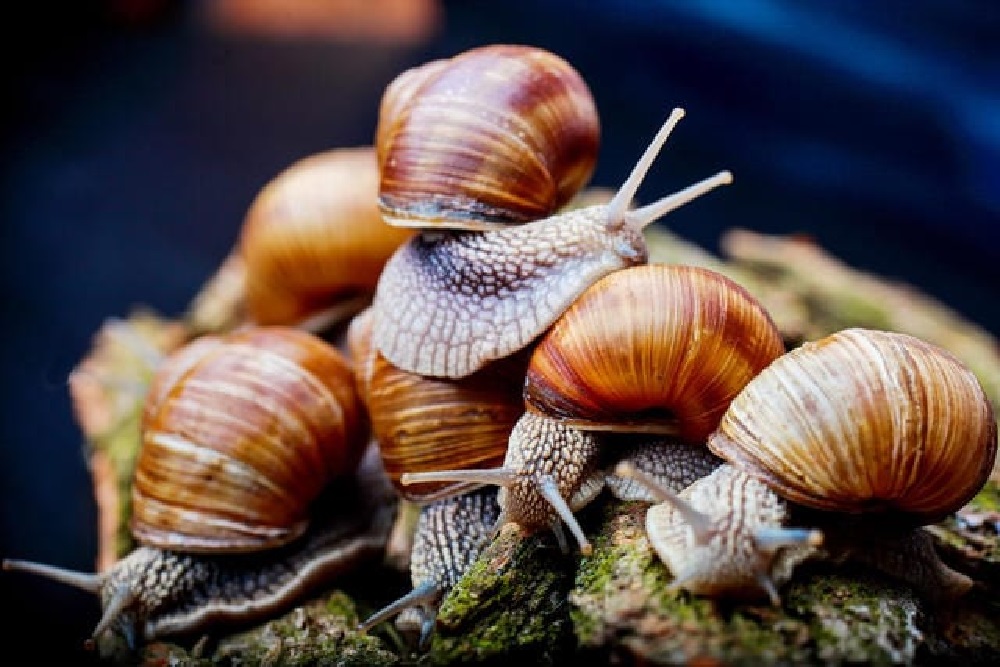Economy
The $1 Billion Snail Farming Industry That You Would Not Regret Joining

Snail farming, also known as heliciculture, is a type of agricultural practice that involves the rearing of snails for various purposes, including food, cosmetics, and research.
Snail farming has gained popularity in recent years due to its high profitability and low maintenance cost. Snail meat is a delicacy in many countries, and its demand is increasing worldwide due to its high protein and low-fat content.
The basics of snail farming involve selecting the right species of snail, setting up a suitable environment, providing a balanced diet, and managing their breeding and health. Snails are hermaphrodites, meaning they have both male and female reproductive organs.
However, they still require a partner to mate and lay eggs. Snails can lay hundreds of eggs at once, and their eggs can take between two weeks to a month to hatch. Once hatched, the baby snails require a suitable environment to grow and thrive.
Key Takeaways
Snail farming is a profitable agricultural practice that involves rearing snails for various purposes.
The basics of snail farming involve selecting the right species of snail, setting up a suitable environment, providing a balanced diet, and managing their breeding and health.
Snails are hermaphrodites and require a partner to mate and lay eggs. They can lay hundreds of eggs at once, and their eggs can take between two weeks to a month to hatch.
Basics of Snail Farming
Snail farming, also known as heliciculture, is an agricultural practice that involves the rearing of snails for commercial purposes. The practice has gained popularity in recent years due to the high demand for snail meat, which is considered a delicacy in many parts of the world. In this section, we will discuss the basics of snail farming, including understanding snail biology and choosing the right snail species.
Understanding Snail Biology
Snails are hermaphrodites, which means that they have both male and female reproductive organs. However, they still require a mate to reproduce. Snails lay their eggs in the soil, and the eggs hatch after about two to four weeks. The young snails, known as hatchlings, take about six months to reach maturity and start reproducing.
Snails are cold-blooded animals, which means that their body temperature is regulated by the environment. They prefer temperatures between 15°C and 25°C and require a humid environment to thrive. Snails are also nocturnal animals, which means that they are active at night and rest during the day.
Choosing the Right Snail Species
There are many species of snails that can be farmed for commercial purposes. However, not all snail species are suitable for farming. The most common species of snails that are farmed for commercial purposes include Helix aspersa, Helix pomatia, and Achatina fulica.
Helix aspersa and Helix pomatia are small snails that are commonly found in Europe. They are easy to farm and reproduce quickly, making them ideal for commercial farming. Achatina fulica, on the other hand, is a large snail that is native to Africa. It is a popular species for farming due to its large size and high meat yield.
When choosing a snail species for farming, it is important to consider factors such as the climate, soil type, and market demand. Snails are sensitive to temperature and humidity, so it is important to choose a species that is well-suited to the local climate. Additionally, it is important to choose a species that is in high demand in the local market to ensure profitability.
Setting Up a Snail Farm
Starting a snail farm requires careful consideration of several factors such as location, farm type, and equipment. Here are the three main subsections that will guide you on how to set up a snail farm.
Farm Location and Environment
The location of the snail farm is crucial to the success of the enterprise. Snails require a humid and warm environment to thrive. Therefore, the ideal location for a snail farm is in areas with moderate temperatures, high humidity, and low wind speeds. The farm should also be located away from urban areas, industrial sites, and polluted environments.
Constructing Snail Habitats
The next step in setting up a snail farm is constructing snail habitats. Snails require a conducive environment that mimics their natural habitat. The snail habitats can be constructed using different materials such as wood, concrete, or plastic. The snail habitats should be well-ventilated and have a controlled temperature and humidity.
Controlling Farm Conditions
The final step in setting up a snail farm is controlling the farm conditions. Snails require specific conditions to thrive, and any deviation from these conditions can affect their growth and productivity. The farm conditions that need to be controlled include temperature, humidity, lighting, and ventilation. The farm should also be protected from predators and pests that can harm the snails.
In summary, setting up a snail farm requires careful planning and consideration of several factors such as location, snail habitats, and farm conditions. By following the above guidelines, one can set up a successful snail farm that will provide a steady source of income.
Snail Diet and Nutrition
Snails are known to be herbivorous animals that feed on a wide range of plant materials. However, not all plants are suitable for snail consumption. Therefore, it is important to provide a balanced diet that meets their nutritional requirements to ensure optimal growth and development.
Feeding Practices
In snail farming, feeding practices play a crucial role in the overall health and productivity of the snails. Snails should be fed at least once a day, preferably in the evening, as they are nocturnal animals. Overfeeding should be avoided as it can lead to obesity and other health problems. It is recommended to provide enough food that can be consumed within 24 hours.
Nutritional Requirements
Snails require a balanced diet that contains protein, carbohydrate, fat, vitamins, and minerals. Protein is essential for growth and development, while carbohydrates provide energy. Fats are also important for energy and insulation. Vitamins and minerals are required in small quantities for various metabolic functions.
According to NSFARMHOUSE, snails should be fed a diet that contains a variety of plant materials such as lettuce, cabbage, broccoli, and chard. These vegetables are rich in protein, carbohydrates, and vitamins. In addition, snails should be provided with calcium supplements to ensure proper shell growth.
It is important to note that snails have a slow digestive system, and therefore, should be fed foods that are easy to digest. Foods that are high in fiber should be avoided as they can cause digestive problems.
In summary, providing a balanced diet that meets the nutritional requirements of snails is essential for successful heliciculture. Proper feeding practices, meeting nutritional requirements, and providing essential supplements and growth factors are key elements for optimal growth and development.
Breeding Techniques
Snail breeding is an essential aspect of snail farming. The first step in breeding is to select healthy and mature snails. Snails are hermaphrodites, meaning that they have both male and female reproductive organs. However, it is still necessary to have two snails mate to produce offspring.
One technique for breeding is to place the snails in a confined space, such as a breeding pen, to encourage them to mate. Another technique is to introduce snails from different geographical locations to increase genetic diversity and improve breeding success.
Lifecycle Stages
Snails go through several stages of development, including egg, hatchling, juvenile, and adult. The eggs are laid in the soil and hatch after a few weeks. The hatchlings are very small and vulnerable, so it is crucial to provide them with a suitable environment to grow and develop.
As the snails grow, they will shed their shells and form new ones. This process is called moulting, and it is a sign of healthy growth. The juvenile stage is a critical time for snails, as they need a balanced diet and proper care to reach maturity.
Once the snails reach maturity, they can begin to reproduce and lay eggs. The lifespan of a snail can vary depending on the species and environment, but most snails can live for several years.
To ensure the success of the breeding and lifecycle management, snail farmers need to provide a suitable environment, proper nutrition, and adequate care for the snails at every stage of development.
Health and Disease Management
Snail farming, like any other livestock farming, requires proper health management to ensure the well-being of the snails and to prevent the spread of diseases.
Common Snail Diseases
Snails are susceptible to a number of diseases, including bacterial, fungal, and parasitic infections. One common disease is the “foot rot” caused by the fungus Saprolegnia ferax, which can be identified by the presence of white, cotton-like growth on the snail’s foot. Another disease is “shell rot,” which is caused by bacteria and can cause the shell to become discolored and weakened. Parasitic infections, such as lungworm and liver fluke, can also affect snails, leading to reduced growth and reproduction.
Preventative Measures
Preventative measures are crucial in managing snail diseases. One of the most important measures is to maintain a clean and hygienic environment. Regular cleaning of the snailery and removal of dead snails can help prevent the spread of diseases. Proper ventilation and temperature control can also help prevent the growth of harmful bacteria and fungi. Additionally, providing a balanced diet and ensuring that the snails have access to clean water can help boost their immune system and prevent infections.
Regular health checks are also recommended to detect any signs of disease early on. This can include visual inspections of the snails, as well as laboratory testing if necessary. In the case of an outbreak, it is important to quarantine infected snails and treat them promptly to prevent the spread of the disease to other snails.
Overall, proper health and disease management is essential for a successful snail farming operation. By following preventative measures and monitoring the health of the snails, farmers can ensure the well-being of their livestock and minimize the risk of disease outbreaks.
Harvesting and Processing
Snail farming involves critical steps of harvesting and processing. These steps are pivotal for successful production, ensuring quality and efficiency in the snail farming industry.
Harvesting Methods
Harvesting snails can be a delicate process that requires careful handling to avoid injury or death of the snails. The most common methods of harvesting snails include manual picking, hand-held nets, and traps. Manual picking involves handpicking snails from the enclosure and is suitable for small-scale snail farming. Hand-held nets are used to scoop up snails from the enclosure, while traps are used to lure snails with bait and trap them.
Cleaning and Storage
After harvesting, the snails should be cleaned to remove dirt, slime, and other debris. This can be done by washing the snails in clean water or by placing them in a container with clean water for a few hours. Snails should be stored in a cool and moist environment to prevent dehydration and death. They can be stored in a container with damp soil or moss, or in a refrigerator at a temperature of 4-8°C.
It is important to note that snails should not be starved before harvesting, as this can lead to weight loss and reduced meat quality. Also, snails should not be harvested during their hibernation period, as this can cause stress and reduce their resistance to disease.
In conclusion, harvesting and processing are critical steps in snail farming that require careful handling and attention to detail. By following the right methods of harvesting and cleaning, snail farmers can ensure high-quality production and profitability.
Understanding the Market
Before marketing snails, it is essential to understand the market. Snails are a delicacy in some parts of the world, and the demand for them is high. The market can be segmented into two categories: local and international. The local market is usually made up of restaurants, hotels, and individual consumers. On the other hand, the international market is made up of snail importers and exporters.
To tap into the local market, snail farmers can approach restaurants and hotels and offer their products. They can also sell directly to individual consumers through farmer’s markets and online platforms. To enter the international market, snail farmers need to ensure that their products meet the required standards and regulations. They can then approach snail importers and exporters who will purchase their products.
Sales Strategies
Snail farming is a profitable business, but it requires the right sales strategies to maximize profits. One strategy is to prioritize sustainability and spread awareness about eco-friendly practices. This can give the snail farming business a competitive edge and attract loyal customers.
Another strategy is to leverage social media to promote the snail farm. By creating a social media presence, snail farmers can connect with potential customers, build their brand, and increase sales. They can also offer discounts and promotions to attract new customers and retain existing ones.
In addition, snail farmers can offer value-added products such as snail meat products, snail shells, and snail slime. These products can be sold to cosmetics and pharmaceutical companies, providing an additional source of income.
Overall, understanding the market and implementing effective sales strategies can help snail farmers maximize profits and grow their business.
Sustainability and Ethics
Snail farming is a sustainable and ethical alternative to traditional livestock farming. As a low-carbon-footprint farming option, snail farming has a minimal impact on the environment and is a more ethical way to produce food.
Environmental Impact
Compared to traditional livestock farming, snail farming has a much lower environmental impact. Snails require less space, feed, and water than other livestock, making them a more sustainable option. In addition, snails produce less waste and greenhouse gases than other livestock, making them an environmentally friendly option for farmers.
Ethical Considerations
Snail farming is also more ethical than traditional livestock farming. Unlike other livestock, snails do not require antibiotics or hormones to grow, making them a healthier and more humane option. Additionally, snails are not as intelligent as other livestock, making them less likely to experience stress or anxiety in captivity.
Overall, snail farming is a sustainable and ethical alternative to traditional livestock farming. As consumers become more aware of the impact of their food choices on the environment and animal welfare, snail farming is likely to become a more popular option for farmers and consumers alike.
Economy
CHECK Exchange Rate As Naira Weakens More In Parallel Market

Naira has continued its downward slide in the parallel market on Thursday, exchanging at N1,621/$1, a depreciation from N1,580/$1 recorded just a day earlier on Wednesday.
This represents a N41 decline in 24 hours, deepening concerns among traders and economic watchers about sustained volatility in the FX market.
While the official exchange rate stood at N1,644.00/$1 on Wednesday, according to figures published on the Central Bank of Nigeria (CBN) website, there was no updated official rate published by the CBN several hours after the market close on Thursday.
Meanwhile, market participants at Wuse Zone 4 in Abuja attributed the persistent depreciation to a resurgence in speculative activities, unmet demand from importers, and lingering confidence issues in the foreign exchange market.
Alhaji Aminu Gwadabe, President of the Association of Bureau De Change Operators of Nigeria (ABCON), attributed the ongoing volatility in the forex market to a mix of local and global uncertainties. In a message sent to Nairametrics, he stated:
“The volatility, fears, happenings, and shocks in both the local and international markets called for disdain.
President Trump’s tariff announcements have sent markets into panic, loss of confidence, revenue losses, and budget reviews.”
He added that despite ongoing interventions by the CBN, instability persists.
“As usual, the CBN, being a catalytic actor, must continue to ensure stability through timely interventions. However, volatility remains a challenge and needs to be more comprehensively addressed,” Gwadabe said.
He further called for an expanded policy transmission mechanism to better serve the retail end of the FX market.
“It is therefore necessary for the CBN to reevaluate the efficacy of that Policy transmission mechanisms and expand its scope to the BDCs retail segment of the market to cater for the needs of the critical retail needs of invisible transactions where the BDCs pose the most potent tool of the CBN policy transmission mechanism.”
Dr. Muda Yusuf, CEO of the Centre for the Promotion of Private Enterprise (CPPE), also linked the naira’s recent struggles to global developments and speculative pressures.
“This is not unconnected to recent policy signals from President Trump and global oil price movements. The market is heavily information-driven, and speculative pressure has spiked following the tariff announcements,” Yusuf explained.
“Now that Trump appears to be having second thoughts, we might even see a bit of a breather in the FX market,” he added.
Meanwhile, traders on the ground say the situation is being worsened by the uncertainty surrounding ongoing government reforms and inconsistent access to official FX windows.
“The demand today was unusually high, especially from small businesses that can’t access the banks. It’s putting pressure on our supply,” a trader at Abuja’s Wuse Zone 4, who asked not to be named stated.
The spread between the official exchange rate of N1,644/$1 and the parallel market rate of N1,621/$1 narrowed slightly on Thursday, a sign that some convergence may be taking place, despite persistent volatility.
Market analysts warn that unless the CBN resumes consistent interventions or significantly boosts FX liquidity, the naira may continue to face downward pressure in the weeks ahead
The continued slide of the naira, despite heightened CBN interventions, signals persistent challenges in Nigeria’s FX liquidity and structural demand-supply mismatch.
Economy
Asian stocks jump as Trump postpones painful tariffs

Stocks rocketed Thursday as a relief rally spread through markets after Donald Trump paused crippling tariffs on US partners, with Chinese markets even brushing off his decision to ramp up duties on Beijing to 125 percent.
The across-the-board gains tracked a blistering performance on Wall Street as the US president said he would delay for 90 days measures announced last week that set off a firestorm on trading floors and sparked global recession fears.
Trump said he would keep in place a basic levy of 10 percent on dozens of countries but upped the ante in his brutal trade war with superpower rival China by hitting it even harder after it retaliated.
China’s own 84 percent retaliatory measures kicked in at 0401 GMT Thursday, later saying that US tariffs would “severely impact the stability of the global economic order”.
Trump made the decision because he said investors were “jumping a little bit out of line” as markets collapsed and US Treasuries — considered the safest option in times of crisis — were also showing signs of cracking on concerns about the world’s top economy.
People “were getting yippy, a little bit afraid”, he added, referring to a term in sports to describe a loss of nerves.
The extra tariffs on Beijing, however, were “based on the lack of respect that China has shown to the world’s markets”, Trump said.
The president denied he had made a U-turn, telling reporters that “you have to be flexible”.
And his top trade advisor, Peter Navarro, said, “This will go down in American history as the greatest trade negotiating day we have ever had.
“We’re in a beautiful position for the next 90 days, we’ve got over 75 countries that are going to come in and negotiate with us and what they’re going to have to do, without fail, is they’re going to have to lower their non-tariff barriers.”
Trump’s shock announcement on his Truth Social network sparked a buying frenzy as Asian and European investors chased beaten-down stocks.
“Asia markets are flipping the switch — from fear to euphoria — as Trump throws a 90-day lifeline, pausing the reciprocal tariff barrage,” said Stephen Innes at SPI Asset Management.
“The president’s post nodded to the ‘yippy’ reaction to his historic hikes, and honestly, that sums it up.
“We just witnessed one of the all-time bouncebacks — and now, we look for Asia investors, much like their North American counterparts, to step in and buy the ‘yips’.”
Hong Kong rallied more than two percent — a third day of gains after collapsing more than 13 percent on Monday in its worst day since 1997 during the Asian financial crisis. Shanghai gained more than one percent.
The two markets have been given extra support by optimism that China will unveil fresh stimulus to support its economy in light of the tariff measures. Official data showing another drop in consumer prices last month added to those hopes.
– ‘Fear to euphoria’ –
Tokyo’s Nikkei surged more than nine percent, while Taipei’s 9.3 percent gain was its best rise on record — after Monday’s 9.7 percent drop represented its worst fall.
Seoul, Singapore, Jakarta, Sydney, Saigon and Bangkok climbed between four and 6.6 percent. Manila and Wellington were also well in the positive territory.
London, Paris and Frankfurt soared at the open.
Tech firms were the standout performers, with Sony, Sharp, Panasonic and SoftBank chalking up double-digit gains, while airlines, car makers and casinos also enjoyed strong buying.
Apple suppliers posted strong rallies — Hong Kong-listed AAC Technologies surged 5.6 percent and in Taiwan, Hon Hai added almost 10 percent.
Gold surged almost three percent to around $3,120 — around $50 short of its record touched last month — thanks to the weaker dollar and as the uncertainty saw investors rush into the safe haven.
Chihiro Ota, at SMBC Nikko Securities, said: “What happens now? If the US takes a hardline stance (in negotiations), then the market would be disappointed. If it turns out that they can engage in talks, then it may create a room for (an upswing).”
US Treasury yields also edged down after a successful auction of $38 billion in notes, said Briefing.com.
That eased pressure on the bond market, which had fanned worries that investors were losing confidence in the United States.
However, observers warn that the China-US standoff could be another step towards a disengagement from the world’s top two economies.
“The escalation of the trade war between the US and China suggests that a full trade decoupling is increasingly likely,” said Mali Chivakul, emerging markets economist at J. Safra Sarasin bank.
“Even if we may see a de-escalation later, a decoupling could still be the result.”
Trump’s trade war is also causing a headache for the US Federal Reserve as it weighs whether to cut interest rates to protect the economy, or keep them elevated to ward off the inflation many say tariffs will fuel.
Minutes from its March meeting, released Wednesday, showed members felt they “may face difficult tradeoffs if inflation proved to be more persistent while the outlook for growth and employment weakened”.
Oil prices edged down after bouncing more than four percent Wednesday, though they remain under pressure amid concerns about the global economy and its impact on demand.
– Key figures around 0715 GMT –
Tokyo – Nikkei 225: 9.1 percent at 34,609.00 (close)
Hong Kong – Hang Seng Index: UP 2.7 percent at 20,804.08
Shanghai – Composite: UP 1.2 percent at 3,223.64 (close)
London – FTSE 100: UP 6.1 percent at 8,145.26
Dollar/yen: DOWN at 147.05 yen from 147.82 yen on Wednesday
Euro/dollar: UP at $1.0968 from $1.0948
Pound/dollar: UP at $1.2875 from $1.2810
Euro/pound: DOWN at 85.20 pence from 85.45 pence
West Texas Intermediate: DOWN 0.6 percent at $62.00 per barrel
Brent North Sea Crude: DOWN 0.7 percent at $65.04 per barrel
New York – Dow: UP 7.9 percent at 40,608.45 (close)
AFP
Economy
Mobile Money transactions hit $1.68trn in one year

Mobile money platforms processed about 108 billion transactions valued at $1.68 trillion in 2024, according to GSMA’s ‘State of the Industry Report on Mobile Money 2025’ report released Tuesday.
GSMA’s mobile money programme works to advance the mobile money ecosystem of communities that lack access to more traditional banking services. The global body for telecom operators stated that mobile money transaction volumes increased by 20 percent year-on-year, while transaction values grew by 16 percent, up from a 13 percent increase in 2023.
“Transaction volumes and values for mobile money accounts experienced robust double-digit growth in 2024. Approximately 108 billion transactions, totalling over $1.68 trillion, were processed through mobile money accounts in 2024,” the report said.
Vivek Badrinath, director general of GSMA, said mobile money has emerged as a powerful driver of financial inclusion and economic growth. “Its continued success depends on supportive regulatory environments that promote innovation, accessibility, and help unlock the full socio-economic potential.
“To ensure mobile money remains accessible, affordable, and safe, it is vital for governments and regulators to work with financial service providers to support financial literacy programs, empowering underserved populations and opening new opportunities for financial decision-making,” he said.
The report stated that the GDP of countries with mobile money services increased by approximately $720 billion by 2023, reflecting a 1.7 percent increase. In Sub-Saharan Africa, mobile money added about $190 billion to GDP in the same year.
“The region remains the leader in mobile money, with active accounts increasing notably in East and West Africa. East Africa was highlighted for its growth in active accounts in 2024, followed by Southeast Asia and West Africa. Countries in East Asia-Pacific, including Cambodia, Fiji, the Philippines, and Vietnam, also demonstrated growth, attributed to favorable regulatory conditions.”
GSMA noted that mobile money providers in East Asia-Pacific have evolved to offer comprehensive financial services, with 44 percent providing credit services by June 2024. However, challenges persist, particularly for women, as eight of the 12 surveyed countries reported disparities in mobile money ownership based on gender.
“Nearly 60 percent of mobile money providers are addressing these gaps by implementing digital literacy initiatives,” the report said.
Mobile money reached two significant milestones in 2024, surpassing two billion registered accounts and over half a billion active monthly users across the globe. The industry took 18 years to achieve one billion registered accounts and 250 million active users from 2001, but this has doubled in the last five years.
-

 News4 hours ago
News4 hours agoInsecurity: Criminals Cart Away NSA Ribadu’s Office Hilux During Juma’at Prayer In Abuja
-

 News13 hours ago
News13 hours agoWe only had lunch with Buhari not 2027 politics -El-Rufai
-

 News13 hours ago
News13 hours agoSad! Explosion rocks Lagos
-

 News13 hours ago
News13 hours agoParts of Abuja, Niger in total darkness -AEDC confirms
-

 News12 hours ago
News12 hours agoIbas gives reasons why Sole Administrators were appointed for Rivers councils
-

 News11 hours ago
News11 hours agoUS embassy announces new requirements for visa interviews for Nigerian applicants
-

 News7 hours ago
News7 hours agoOERAF Rounds Up Late Chief Ekuogbe Rowland Akpodiete’s remembrance with Novelty Match
-

 News11 hours ago
News11 hours agoFive countries with easy work visas in 2025






